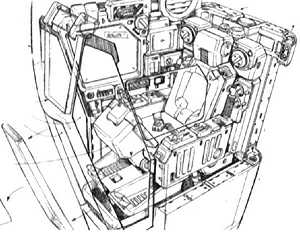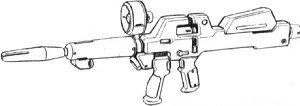NOTES ABOUT MOBILE SUIT
by Zivago
As you already know, mobile suits (MS)
are anthropomorphic robots operated by a human pilot. First types
has been made by Jion Industries Inc. engineers for
military purposes, and then also for civilian ones (mobile
workers). Normally they’re from 50 to 80 feet tall
and about 50 tons weight, but it depends on the environment: the
elements the structure and the armour are made of are different
according to gravity factor (e.g. carbon fibres on the
Earth, titanium alloys in space). Anyway, invention of gandarium
gamma, a very light and strong titanium alloy, has solved
weight’s variation problems.
Different from MS is the mobile armor (MA), a non-anthropomorphic robot. It is quite like a spaceship, but it’s smaller and, therefore, much more rapid and manoeuvrable, with few pilots (seldom more than one) and an impressive firing power.
Mobile
Suits are totally controlled by a powerful neural computers
network that manages the self-perception software,
space-time emulation programmes able to elaborate all the data
about MS’ position, calculating the thrustes to let its
motion and balance when operating in gravity (Electronic
Motion and Balancing System). Thank to this system MS is
quite simple to operate: the pilot has just to steer, control
speed, aim and fire, like any other military vehicle. Cockpit  display, whether mundane flat panel or 360-degrees panoramic
monitor, shows the surroundings as if the pilot were in the
MS’ head, thank to connection with the optical sensors
installed behind head’s ocular panels.
display, whether mundane flat panel or 360-degrees panoramic
monitor, shows the surroundings as if the pilot were in the
MS’ head, thank to connection with the optical sensors
installed behind head’s ocular panels.
A
special operating system is the PCS (Psychic Communication
System) that, without traditional electronic and/or
mechanical controls, translates pilot’s brainwaves directly
into commands for the computers network. But this system is
suitable for newtype people only, because it requests
higher psychic capacities. Telepathic impulses systems, by the
way, are the only ones able to let remote control without being
disturbed by Minovski particles (read below), and
that’s why Psycho MS are often provided with remote
controlled drones. MA can be provided with PCS as well in order
to use remote-controlled weapons and, if equipped with a Minovski
particles’ generator, they can even operate in gravity.
even operate in gravity.
Some MS
types, mainly federal ones, are provided with auto-learning
operating systems. The first one was ALCS (Auto-Learning
Computer System), installed on RX-78/2 Gundam, able
to record actions and manoeuvres and to repeat them automatically
in the same fighting conditions. But the good outcome of this
system was due above all to its pilot capacities, rather than its
own effectiveness: it was barely selective, and it was often
necessary to switch it off so that it wouldn’t repeat
previous mistakes. A further step was the ALICE (Auto-Learning
Intelligence Core Equipment) installed on MSA-0011 Superior
Gundam, but its outcomes weren’t good enough as well:
it was so selective that it developed a sort of
self-consciousness, with unforeseeable risks for the pilot.
and it was often
necessary to switch it off so that it wouldn’t repeat
previous mistakes. A further step was the ALICE (Auto-Learning
Intelligence Core Equipment) installed on MSA-0011 Superior
Gundam, but its outcomes weren’t good enough as well:
it was so selective that it developed a sort of
self-consciousness, with unforeseeable risks for the pilot.
Concerning
supply and propulsion systems, main MS and MA power source is the
atomic energy produced by their nuclear fusion microreactors. The
reaction runs on helium 3 and deuterium, a
light isotope of helium and a heavy one of hydrogen,
respectively. In the process a neutron is transferred from
deuterium’s nucleus to helium 3’s one, producing
regular helium and hydrogen atoms. The advantage of this unusual
fusion reaction is that it emits few stray neutrons and thus
needs less radiation shielding. Anyway, helium 3 is a very rare
isotope of a very scarce element, but it’s present in
significant quantities in the Moon’s soil, and in mass
quantities in Jupiter’s atmosphere: that’s why in the
universal era Jupiter missions (Jupitoris, Thousand Jupiter)
have got vital importance. On the other hand, propulsion systems
employ rockets with liquid propellant (hydrogen-oxygen).
MS armament
is different according to each version. Basically, every Jion
MS has been soon provided with a Minovski
particles’ generator, while federal MS have got it only
since 81 U.C., with first Anaheim Electronics types.
Another basic MS equipment is a couple of 60 mm Vulcan cannons
and a portable weapon at least (bazooka, beam rifle, beam sabre,
ecc.). Normally, MA armament is more powerful than MS one, but it
is less versatile at the same time.
Minovski
particles are small and short-lived subnuclear particles with
unique properties. Their production is a side-effect of helium
3-deuterium nuclear fusion process discovered by nuclear
physician Yuri Torenov Minovski. If scattered in bulk,
these particles block low frequency electromagnetic radiations,
like radio waves, so that their introduction in the battlefield
prevents the use of radar and radio systems, and reduces
infra-red sensors effectiveness. When electrically charged Minovski particles
form a three-dimensional grid called I-field, which can deflect
and confine charged particles better than a magnetic field.
I-fields are used to contain superheated plasma into MS and MA
fusion reactors; in the Minovski flight system to
provide lift and anti-gravity thrust (as used in the project Victory), or to protect MS and MA
from particles-beam weapons (as you can see for F91 “shield”). At last, if compressed an I-field
gives off hi-energy mega particles that can be collected, focused
and fired as in conventional particles-beam weapons most of MS,
MA and warships are provided with in the universal era.
Most mobile suit model numbers consist of a two or three letter prefix, followed by a number. The number almost always indicates the order in which the mobile suit was developed, with the first mobile suit in a series being 01, the second 02, and so forth. After the number, you’ll often see additional letters, which indicate variations and customizations. The meaning of these tacked-on letters varies from case to case. Often, they just indicate a series of minor improvements; the Zack II went through the MS-06A, MS-06B and MS-06C versions before the development of the ubiquitous MS-06F. While the letters sometimes convey useful information — D for desert, C for cannon, M for marine and so on — they’re often used inconsistently. You may also see an additional number tacked onto the end. This usually approximates a version number; the RX-78/1 was the first version of the Gundam, the RX-78/2 was the second, etc.
Federal Forces model numbers have a two or three letter prefix, followed by a number. The prefixes for mobile suits begin with the letter R, and the prefixes for fighter craft begin with the letter F. So that RGC is for mass-produced Guncannon, RGM is for mass-produced Gundam, RGZ is for mass-produced Zeta Gundam, RMS is for general purpose mobile suit, and so on. The number following the prefix is usually the U.C. year in which development began. Anyway, in 85 U.C. this system changes because of the number of factories increasing, so that the first two digits of the number following the prefix now indicate where the mobile suit has been produced, while the third digit indicates the order of development. Here are the codes of main factories: 10 for Granada, 11 for Luna 2, 12 for Solomon-Kompei Island, 13 for A Bao A Qu-Gate of Sedan, 14 for Pezun, 15 for New Guinea, 16 for Kilimanjaro, 17 for Gryps (Side 7), 18 and 19 for Jaburo. Another different way regards the experimental mobile suits produced by the Newtype Network Labs. In these cases the letter prefix consists of the RX code following a different letter, according to the different NNL in which the model has been produced (MRX for Murasame newtype labs, ORX for Pezun newtype labs and NRX for New York newtype labs). After the letter prefix then you find the number indicating the order of development. The prefix PMX, at last, indicates the models directly projected by Paptimus Scirocco for the Titans.

This website has been created on March 1 2000 for informational, promotional and entertainment purposes only. Mobile Suit Gundam™ and its various trademarks & images are © copyright Sotsu Agency, Sunrise and TV Asahi, Kadokawa Shoten, Bandai and its varying artists. Gundam, a space epic website is not affiliated with Bandai, Sunrise, or their respective trademarks in any official capacity, and its author doesn’t mean to violate any copyright. All rights of the author reserved. Unauthorized copying prohibited. For every need please E-mail to gtavassi@libero.it.